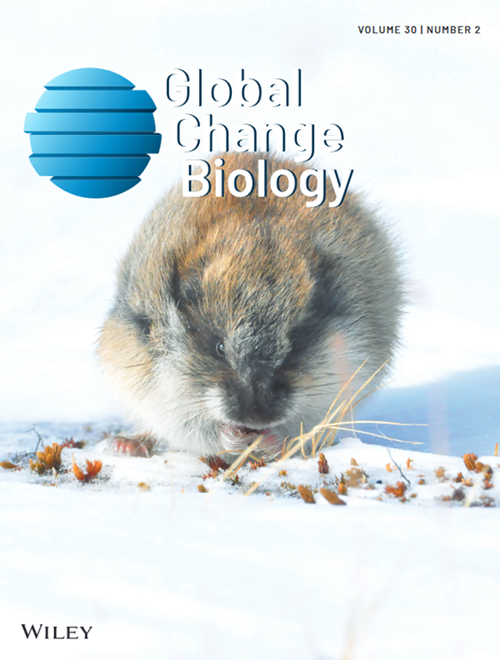Mapping Resilient Landscapes to Climate Change in a Megadiverse Country
IF 12
1区 环境科学与生态学
Q1 BIODIVERSITY CONSERVATION
引用次数: 0
Abstract
The effects of global climate change on biodiversity and ecosystem functioning are unevenly distributed in the geographic space. Identifying sites more suitable to sustain biodiversity in a changing climate is essential to both species conservation and restoration strategies at different scales. Here, we map terrestrial climate‐resilient sites for biodiversity across Brazil to identify sites with greater chances of providing suitable conditions for species to persist under regional climate change. Our mapping combines spatial metrics based on landscape heterogeneity, a proxy for microclimatic variability, and local connectedness, a measure of connectivity between habitats, to determine landscape resilience, assuming that resilience to climate change will be greater the more heterogeneous the characteristics of local habitats are and the more connected they are in the landscape. Our results show that within each biome, medium to high resilient sites are mostly found in the Amazon (40% of the biome) and Pantanal (38%). Low resilience, conversely, is concentrated in the Atlantic Forest (41% of the biome), followed by Cerrado (37%), Pampa (36%), and Caatinga (34%). Landscape resilience information has the potential to be used to effectively guide decision‐making and public policy on strategies for conservation, restoration, and sustainable use practices. Priority for conservation should be on high resilience sites as they have the potential to sustain biodiversity in face of undergoing and future climate change. Other approaches could be used in situations of medium to low resilience also, such as: conservation of current corridors in sites with high local connectedness, but low landscape heterogeneity; restoration of natural vegetation on sites that show high landscape heterogeneity, but low local connectedness; and sustainable practices in areas of low resilience. Our study provides an updated method to pinpoint climate‐resilient sites for biodiversity which was applied to a megadiverse country but is applicable to any ecosystem around the globe.在一个超级多样化的国家绘制适应气候变化的弹性景观图
全球气候变化对生物多样性和生态系统功能的影响在地理空间上呈不均匀分布。确定更适合在气候变化中维持生物多样性的地点对于不同尺度的物种保护和恢复策略都是至关重要的。在这里,我们绘制了巴西陆地生物多样性的气候适应性分布图,以确定在区域气候变化下更有可能为物种提供适宜生存条件的地点。我们的制图结合了基于景观异质性的空间度量(代表小气候变异性)和本地连通性(衡量栖息地之间的连通性)来确定景观的复原力,假设当地栖息地的特征异质性越大,它们在景观中的联系越紧密,对气候变化的复原力就越大。结果表明,在每个生物群系中,中至高弹性地点主要分布在亚马逊(占生物群系的40%)和潘塔纳尔(38%)。相反,恢复力较低的地区集中在大西洋森林(占生物群系的41%),其次是塞拉多(37%)、潘帕(36%)和卡廷加(34%)。景观恢复力信息有可能有效地指导保护、恢复和可持续利用策略的决策和公共政策。应优先保护具有高复原力的地点,因为它们在面临正在发生和未来的气候变化时具有维持生物多样性的潜力。其他方法也可用于中低恢复力的情况,例如:在具有高度局部连通性但景观异质性低的地点保护现有走廊;景观异质性高、局部连通性低的立地自然植被恢复以及在低恢复力地区的可持续实践。我们的研究提供了一种更新的方法来确定生物多样性的气候适应性地点,这种方法适用于一个超级多样性国家,但适用于全球任何生态系统。
本文章由计算机程序翻译,如有差异,请以英文原文为准。
求助全文
约1分钟内获得全文
求助全文
来源期刊

Global Change Biology
环境科学-环境科学
CiteScore
21.50
自引率
5.20%
发文量
497
审稿时长
3.3 months
期刊介绍:
Global Change Biology is an environmental change journal committed to shaping the future and addressing the world's most pressing challenges, including sustainability, climate change, environmental protection, food and water safety, and global health.
Dedicated to fostering a profound understanding of the impacts of global change on biological systems and offering innovative solutions, the journal publishes a diverse range of content, including primary research articles, technical advances, research reviews, reports, opinions, perspectives, commentaries, and letters. Starting with the 2024 volume, Global Change Biology will transition to an online-only format, enhancing accessibility and contributing to the evolution of scholarly communication.
 求助内容:
求助内容: 应助结果提醒方式:
应助结果提醒方式:


